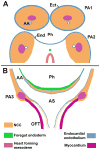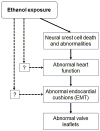Connecting teratogen-induced congenital heart defects to neural crest cells and their effect on cardiac function
- PMID: 25220155
- PMCID: PMC4238913
- DOI: 10.1002/bdrc.21082
Connecting teratogen-induced congenital heart defects to neural crest cells and their effect on cardiac function
Abstract
Neural crest cells play many key roles in embryonic development, as demonstrated by the abnormalities that result from their specific absence or dysfunction. Unfortunately, these key cells are particularly sensitive to abnormalities in various intrinsic and extrinsic factors, such as genetic deletions or ethanol-exposure that lead to morbidity and mortality for organisms. This review discusses the role identified for a segment of neural crest in regulating the morphogenesis of the heart and associated great vessels. The paradox is that their derivatives constitute a small proportion of cells to the cardiovascular system. Findings supporting that these cells impact early cardiac function raises the interesting possibility that they indirectly control cardiovascular development at least partially through regulating function. Making connections between insults to the neural crest, cardiac function, and morphogenesis is more approachable with technological advances. Expanding our understanding of early functional consequences could be useful in improving diagnosis and testing therapies.
Keywords: cardiac; physiology; cardiogenesis; folic acid; neural crest cells; optical coherence tomography; ethanol; prenatal alcohol exposure; teratogen.
© 2014 Wiley Periodicals, Inc.
Conflict of interest statement
The authors have no conflict of interest to declare pertinent to this review.
Figures



Similar articles
-
Genetic and developmental modulation of cardiac deficits in prenatal alcohol exposure.Alcohol Clin Exp Res. 2000 Jan;24(1):102-9. Alcohol Clin Exp Res. 2000. PMID: 10656199
-
The neural crest in cardiac congenital anomalies.Differentiation. 2012 Jul;84(1):25-40. doi: 10.1016/j.diff.2012.04.005. Epub 2012 May 15. Differentiation. 2012. PMID: 22595346 Free PMC article. Review.
-
Cardiac Development and Factors Influencing the Development of Congenital Heart Defects (CHDs): Part I.Int J Mol Sci. 2024 Jun 28;25(13):7117. doi: 10.3390/ijms25137117. Int J Mol Sci. 2024. PMID: 39000221 Free PMC article. Review.
-
Cardiac outflow tract defects in mice lacking ALK2 in neural crest cells.Development. 2004 Jul;131(14):3481-90. doi: 10.1242/dev.01214. Development. 2004. PMID: 15226263
-
Neural crest development in fetal alcohol syndrome.Birth Defects Res C Embryo Today. 2014 Sep;102(3):210-20. doi: 10.1002/bdrc.21078. Epub 2014 Sep 15. Birth Defects Res C Embryo Today. 2014. PMID: 25219761 Free PMC article. Review.
Cited by
-
Time to go: neural crest cell epithelial-to-mesenchymal transition.Development. 2022 Aug 1;149(15):dev200712. doi: 10.1242/dev.200712. Epub 2022 Jul 29. Development. 2022. PMID: 35905012 Free PMC article. Review.
-
Evaluating the effects of maternal alcohol consumption on murine fetal brain vasculature using optical coherence tomography.J Biophotonics. 2018 May;11(5):e201700238. doi: 10.1002/jbio.201700238. Epub 2018 Feb 26. J Biophotonics. 2018. PMID: 29292845 Free PMC article.
-
Electrophysiological phenotyping of left ventricular noncompaction cardiomyopathy in pediatric populations: A systematic review.Physiol Rep. 2024 May;12(9):e16029. doi: 10.14814/phy2.16029. Physiol Rep. 2024. PMID: 38684446 Free PMC article.
-
Tongue Abnormalities Are Associated to a Maternal Folic Acid Deficient Diet in Mice.Nutrients. 2017 Dec 28;10(1):26. doi: 10.3390/nu10010026. Nutrients. 2017. PMID: 29283374 Free PMC article.
-
Increased regurgitant flow causes endocardial cushion defects in an avian embryonic model of congenital heart disease.Congenit Heart Dis. 2017 May;12(3):322-331. doi: 10.1111/chd.12443. Epub 2017 Feb 17. Congenit Heart Dis. 2017. PMID: 28211263 Free PMC article.
References
-
- Abu-Issa R, Smyth G, Smoak I, Yamamura K, Meyers EN. Fgf8 is required for pharyngeal arch and cardiovascular development in the mouse. Development. 2002;129(19):4613–4625. - PubMed
-
- Adams MS, Bronner-Fraser M. Review: the role of neural crest cells in the endocrine system. Endocr Pathol. 2009;20(2):92–100. - PubMed
-
- Adickes ED, Mollner TJ, Makoid MC. Ethanol-induced teratogenic alterations in developing cardiomyocytes in culture. Alcohol Alcohol Suppl. 1993;2:283–288. - PubMed
Publication types
MeSH terms
Substances
Grants and funding
LinkOut - more resources
Full Text Sources
Other Literature Sources
Medical

